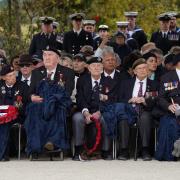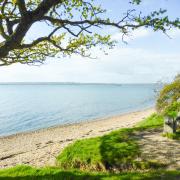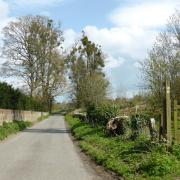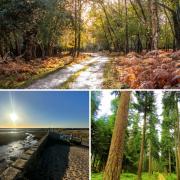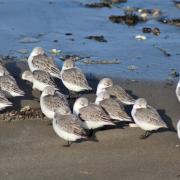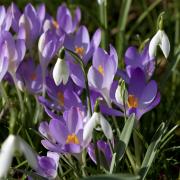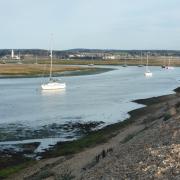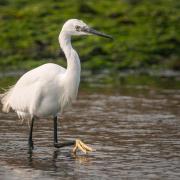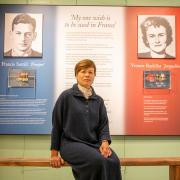Revelling in a second career, Gill Dollery has left teaching behind and is fast becoming a Hampshire name to watch out for.
That artists and their work portray distinctive characteristics is a concept which not only reinforces creative conviction on their part, it also induces a degree of wisdom amongst the general public. For, no matter how little people may know - or think they know - about art, many are, at least, capable of identifying artists either through their style or subject matter. Most would pass the test of distinguishing a Monet from a Lowry, for example. And Rubens’ prolific portraits have little chance of being confused with those of one of our most contemporary British artists, David Hockney.
Which brings me to Gill Dollery and my fascination of her portfolio. True, this Hampshire artist’s name may not trigger the same level of familiarity as the aforementioned greats, yet the range of topics, methods and materials she exploits defies any art lover to pigeonhole her compositions.
When I catch up with Gill she is holidaying on the Isle of Wight but happy to take a break to talk about her vocation. We begin by discussing the media which appeal to her. “My choice of pastel is influenced by light,” she begins. “The colours are so bright and beautiful and if I want to make a print from pastel, the tones just shine out. You get wonderful colours in acrylics too; they’re no longer brash like they used to be. I run workshops in acrylics and pastels.”
Gill also produces collages and oil paintings. And, to prove variety isn’t only limited to her preferred media, the subjects that appeal to her range from lighthouses to ice skaters; not to mention the historic Burlesdon Brickworks and a row of beach huts at Calshot.
Her passion for her hobby – for this is how she regards her calling – is fuelled, I sense, by a continuing eagerness to absorb knowledge.
“It’s like playing the flute, you have to practise. When I started off I wasn’t brilliant but if you do a little sketching every day, hopefully you improve. I also read art books, go to exhibitions and pick up ideas. It’s important to keep your drawing skills up to date. If you’re enthusiastic about a subject then you carry on.”
Given such keenness and commitment it is surprising to learn that Gill only seriously devoted herself to painting after she took early retirement. Having majored in Art at college, she decided on an initial career as a Primary School Teacher and, although this enabled her to use her knowledge of, and flair for, art in the classroom, her innate skills came secondary to a job which, she felt, offered more stability than she might have experienced as an artist.
So when did she finally change her priorities and promote art to the top of her agenda?
“When my three children left home I took over one of the spare bedrooms, which became my working space. And in 1995 I joined Rowlands Castle Painting Society. This encouraged me to improve. I attended classes every fortnight and learnt new techniques. Actually, I’m now Principal of the Society. But retiring early, at 55, was the real driving force for me to spend more time with my art.”
Successful artists must not only paint, of course, they also need a market for their work. Gill’s first opportunity to exhibit her canvasses came via the building of a new medical centre in which the architect created space for a number of artists to display paintings. Gill organised nine colleagues and between them they were able to take advantage of a captive audience. These days she is regularly involved in exhibitions around the county including Titchfield and Denmead in Waterlooville. Such events provide a much appreciated opportunity to meet potential buyers, as well as interact, and swap tips, with other artists.
But let’s just revisit the scope of Gill’s interest. Again, she doesn’t limit herself to a representational style in which images depict a place or scene easily recognised. For this is a woman intent on stretching the artistic knowledge of her public. “I’m currently exploring the boundaries between representation and abstraction,” she explains. “I want people to use their imaginations; for instance, to find a figure lurking behind an object. In fact, I’d like to concentrate on more abstract work and try, perhaps, to achieve a different edge to my pictures.”
The subtle determination of this artist is quietly encouraging. She may not have spent all her working life in this role but her current productivity level more than makes up for those years in academia. And one of the biggest attractions of her collection must surely be its diversity. An oil painting of the Ship Inn at Langstone, for instance, differs in topic and texture to the watercolour snow scene at Portchester, though both paintings are equally as appealing. Does their rendering of local buildings imply a trademark style of the artist, maybe?
Not at all. In Gill’s acrylic Summer Evening at Langstone, she has created a relaxing scene that reflects community life. While the delightful watercolour, A Lovely Couple, in which two Buff Orpingtons nestle side by side, truly symbolise Gill’s range of interest.
The lure of the coast is, however, an obvious influence in her work.
“There is lovely light here. And the boats, shapes, masts, sky and colour of Hampshire are all inspirational.”
Although she frequently carries a sketchbook with her – Picnic Painting Days with the Rowlands Castle Painting Society mean summer Tuesday mornings are set aside for outside sketching – the bulk of painting is completed in the garden studio her husband had built for her five years ago and which provides the freedom of having her own space alongside the privilege of making a mess without having to tidy it away. As well as providing Gill with an appropriate environment in which to create, her husband has also taken on the responsibility of mounting the paintings: “He’s learnt about framing from scratch, he’s quite brilliant!”
When not working on commissions or exhibition pieces she enjoys country walks, cooking, sailing, and looking after her cat and chickens at her home on The Solent coastline. But I suspect, like most artists, Gill’s imaginative quality rarely switches off, the lure of potential new subjects being a constant presence.
And although painting gives her as much pleasure now as it has ever done, she also shares a frustration that is, perhaps, common amongst creative types – rarely achieving total satisfaction with a project; perhaps being left with a lingering sense that she could have done better. Yet it is that very standard which simultaneously makes her strive to improve, of course, although, thankfully, Gill confesses to occasional moments of fulfilment, “When I finish a picture and realise it is just as I wanted to capture it.”
Such devotion to her profession is as clear and fresh as the landscapes and coastal images that she produces. Teaching may have taken up the bulk of her working life, but these days art is her priority and she is revelling in this opportunity of a second career.
And while Gill’s name may not be as recognisable as those of more celebrated artists, her reputation as a sought after Hampshire artist continues to flourish.






